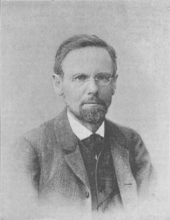The Kreuzhüttenbuben
Die Kreuzhüttenbuben is a short story by the Austrian writer Peter Rosegger that appeared in the October 1898 issue (23rd year, issue 1) of the Graz Heimgarten .
content
The Kreuzhütte, a wooden house with small windows, is located in a narrow high valley of the Alps "with poor shepherds". The Kreuzhüttenbauer had three fields. Because no servant got lost in this wasteland, cramped between towering rocks, the farmer made other arrangements: his young wife bore him the sons Oswald, Toni and Jakob for three consecutive years. Oswald, the eldest son, became a carpenter, Toni became a coal burner and Jakob remained a lumberjack with the landlord all his life. Before that, the three adolescent boys wanted to drink milk all the time. So the father sold his plows, bought cows and turned the fields into pastures.
Years after the father's death, when the boys had finally become “three strong men”, they relieved the dear mother of all the hard work in her dairy farm. Despite his flat feet , Oswald was considered a well-groomed, handsome blond boy. His brothers had also remained civilians because of their ailments. Toni had a heavy hump after falling as a child . Jacob was short and saber-legged . Oswald rarely came home. The two younger ones were attached to the mother. Often they climbed up to the Kreuzhütte with small presents and were called my two " dear fools " by their delighted mother .
When Oswald comes out with the news - he wants to marry a widow under thirty, the Wegscheid landlady in Blachau - the mother is by no means pleased. Nevertheless, she goes on a pilgrimage to Straßkirchen with her three sons with two stops on the way there and back in the bride's inn on the Wegscheide. During the first visit, the mother creeps a strange feeling that intensifies during the second: the bride is ashamed of us.
The sensitive Oswald doesn't say a single word for the rest of the way home and then pulls out with sackcloth at the crossroads. So it is right! means his family, because it is said that this landlady poisoned her husband.
The three sons lived together with their aging mother for years. When his mother's strength waned, Toni gave up burning coal, looked after the cows and goats, cooked food, took care of the rest of the household and looked after his mother. Finally, the sick mother and her boys attend the parish fair . Oswald fulfills the mother's wish; leads them to dance. Almost floating in the dance, the mother dreams of the time fifty years ago, when things would soon be similar in the arms of the cross hut builder at the church fair. Having become dizzy, the son guides her back to her seat. Then she giggles at the boys: “But be real fools.” When the four finally reached their cruiser's hut in the high valley after a two-hour carriage ride, the mother, just like the father decades ago, fell asleep without much pain.
In his youth, the narrator had seen the three boys from the Kreuzhütten as old, wild bachelors. They would not have been food despisers; would occasionally have given an undercurrent wine. The old people basically only talked to old people and mainly played with children.
reception
- In December 1901, Carl Busse discussed Rosegger's Sunshine Collection , which was published in the same year by the Ludwig Staackmann publishing house in Leipzig, and first worked out the “strong talent” of Rosegger, the man “who speaks to the people”. In the same breath Busse paid tribute to Die Kreuzhüttenbuben from the aforementioned volume of stories: “... for a long time the heart holds onto the story of the three 'Kreuzhüttenbuben' who look after their old mother - the song of praise of filial love, which is saturated with the simplest beauty and poetry . "
- In 1903, Hermann Herz alludes to the charcoal burner occupation of the protagonist Toni in the Bonner Borromäus-Blätter when, impressed by Rosegger's description, he writes: “Despite all the soot that covers at least two of them, they are naive extremely great love for their mother so attractive figures ... ”.
- In 1943, the Rosegger biographer Rudolf Latzke noted: "Only one expression of life, a virtue, is reported from the 'Kreuzhüttenbuben', the caressing with their mother, but what a beauty that gives these forest bears!"
literature
expenditure
- The Kreuzhüttenbuben. In: Sunshine . L. Staackmann, Leipzig 1902, p. 40-60 ( archive.org ).
- The Kreuzhüttenbuben . In: Peter Rosegger: The book of novels. First volume, L. Staackmann. Leipzig 1913, pp. 363-380.
Secondary literature
- Litterary monthly reports by Carl Busse , p. 441–451 in: Carl Busse: German monthly for the entire life of the present . Ed .: Julius Lohmeyer . Alexander Duncker publishing house, Berlin 1901 ( archive.org ).
- Rudolf Latzke : Peter Rosegger. His life and work, presented according to the sources . Böhlau, Weimar 1943.
Individual evidence
- ↑ The Kreuzhütten boys. A picture from the folk life of the Alps by Peter Rosegger . In: Heimgarten. 23rd year, October 1898, pp. 25–36.
- ^ Carl Busse, 1901, pp. 441–442
- ^ Carl Busse, 1901, p. 442, 12. Zvu
- ↑ Andrea Asselmann anno 1995: Public library work in the mirror of the magazine 'Borromäusblätter / Die Bücherwelt': Chapter 2.2 Editors and staff , p. 324. See also Thomas Dietzel, Hans-Otto Hügel anno 2012 in the German Literature Archive : German literary journals 1880-1945: A repertory
- ↑ Hermann Herz anno 1903 in the Borromäus-Blätter , Vols. 1–3, p. 238
- ↑ Latzke, Vol. 2, p. 453
